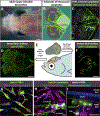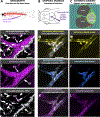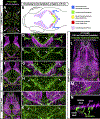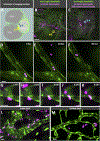Live Imaging of Intracranial Lymphatics in the Zebrafish
- PMID: 33135960
- PMCID: PMC7790877
- DOI: 10.1161/CIRCRESAHA.120.317372
Live Imaging of Intracranial Lymphatics in the Zebrafish
Abstract
Rationale: The recent discovery of meningeal lymphatics in mammals is reshaping our understanding of fluid homeostasis and cellular waste management in the brain, but visualization and experimental analysis of these vessels is challenging in mammals. Although the optical clarity and experimental advantages of zebrafish have made this an essential model organism for studying lymphatic development, the existence of meningeal lymphatics has not yet been reported in this species.
Objective: Examine the intracranial space of larval, juvenile, and adult zebrafish to determine whether and where intracranial lymphatic vessels are present.
Methods and results: Using high-resolution optical imaging of the meninges in living animals, we show that zebrafish possess a meningeal lymphatic network comparable to that found in mammals. We confirm that this network is separate from the blood vascular network and that it drains interstitial fluid from the brain. We document the developmental origins and growth of these vessels into a distinct network separated from the external lymphatics. Finally, we show that these vessels contain immune cells and perform live imaging of immune cell trafficking and transmigration in meningeal lymphatics.
Conclusions: This discovery establishes the zebrafish as a important new model for experimental analysis of meningeal lymphatic development and opens up new avenues for probing meningeal lymphatic function in health and disease.
Keywords: brain; developmental biology; meninges; zebrafish.
Figures








Comment in
-
Lymphatics and the Brain: It's Time to Go Fishing.Circ Res. 2021 Jan 8;128(1):59-61. doi: 10.1161/CIRCRESAHA.120.318496. Epub 2021 Jan 7. Circ Res. 2021. PMID: 33411628 No abstract available.
Similar articles
-
Development and plasticity of meningeal lymphatic vessels.J Exp Med. 2017 Dec 4;214(12):3645-3667. doi: 10.1084/jem.20170391. Epub 2017 Nov 15. J Exp Med. 2017. PMID: 29141865 Free PMC article.
-
Meningeal Lymphatics: An Immune Gateway for the Central Nervous System.Cells. 2021 Dec 1;10(12):3385. doi: 10.3390/cells10123385. Cells. 2021. PMID: 34943894 Free PMC article. Review.
-
Characterization of Zebrafish Facial Lymphatics.Methods Mol Biol. 2018;1846:71-83. doi: 10.1007/978-1-4939-8712-2_5. Methods Mol Biol. 2018. PMID: 30242753
-
Yap1 promotes sprouting and proliferation of lymphatic progenitors downstream of Vegfc in the zebrafish trunk.Elife. 2019 Apr 30;8:e42881. doi: 10.7554/eLife.42881. Elife. 2019. PMID: 31038457 Free PMC article.
-
Understanding the functions and relationships of the glymphatic system and meningeal lymphatics.J Clin Invest. 2017 Sep 1;127(9):3210-3219. doi: 10.1172/JCI90603. Epub 2017 Sep 1. J Clin Invest. 2017. PMID: 28862640 Free PMC article. Review.
Cited by
-
In Vitro, In Vivo, and In Silico Models of Lymphangiogenesis in Solid Malignancies.Cancers (Basel). 2022 Mar 16;14(6):1525. doi: 10.3390/cancers14061525. Cancers (Basel). 2022. PMID: 35326676 Free PMC article. Review.
-
Zebrafish Models of Induced Lymphangiogenesis: Current Advancements and Therapeutic Discovery.Pharmaceuticals (Basel). 2025 Jul 21;18(7):1076. doi: 10.3390/ph18071076. Pharmaceuticals (Basel). 2025. PMID: 40732363 Free PMC article. Review.
-
Brain borders at the central stage of neuroimmunology.Nature. 2022 Dec;612(7940):417-429. doi: 10.1038/s41586-022-05474-7. Epub 2022 Dec 14. Nature. 2022. PMID: 36517712 Free PMC article. Review.
-
Stuck on you: Meninges cellular crosstalk in development.Curr Opin Neurobiol. 2023 Apr;79:102676. doi: 10.1016/j.conb.2023.102676. Epub 2023 Feb 9. Curr Opin Neurobiol. 2023. PMID: 36773497 Free PMC article. Review.
-
The Olfactory Organ Is a Unique Site for Neutrophils in the Brain.Front Immunol. 2022 May 27;13:881702. doi: 10.3389/fimmu.2022.881702. eCollection 2022. Front Immunol. 2022. PMID: 35693773 Free PMC article.
References
-
- Ahn JH, Cho H, Kim JH, Kim SH, Ham JS, Park I, Suh SH, Hong SP, Song JH, Hong YK, et al. Meningeal lymphatic vessels at the skull base drain cerebrospinal fluid. Nature. 2019;572:62–66 - PubMed
Publication types
MeSH terms
Substances
Grants and funding
LinkOut - more resources
Full Text Sources
Other Literature Sources
Molecular Biology Databases

